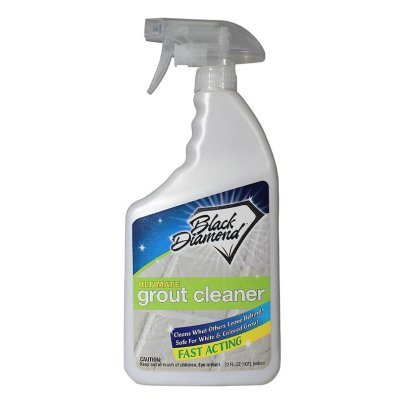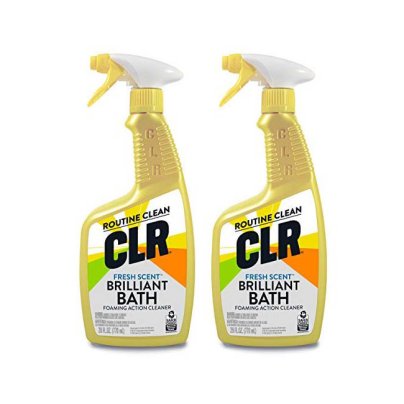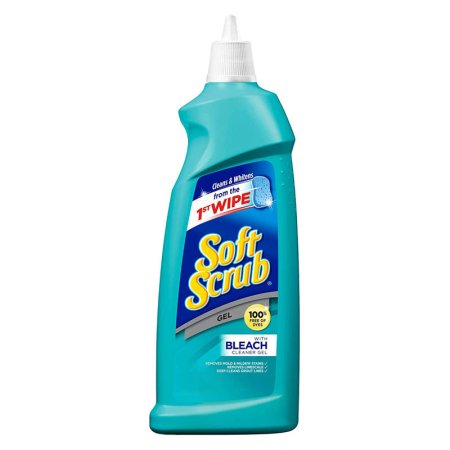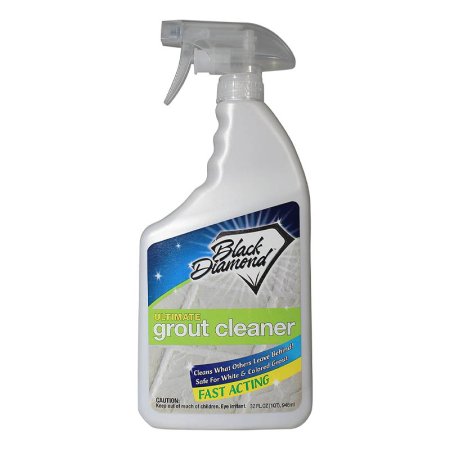
We may earn revenue from the products available on this page and participate in affiliate programs. Learn More ›
Grout isn’t something we usually notice until it becomes grimy, dark, or dingy. However, with the right cleaner, it’s easy to restore grout—and the surrounding tile—to its original beauty. Following application, grout lines can become smoother, brighter, and cleaner. But with so many kinds available, choosing the right grout cleaner can be tough. In order to help make the decision easier, we tested several types of grout cleaners to see which ones worked best and actually stood up to the claims they made to deliver a sparkling-clean result.
As a space filler between laid tile, cement-based grout is made of natural minerals mixed with water. Since it’s slightly porous, grout can become stained through improper care or accidental spills. Plus, dust, dirty water, and soap scum can coat it and even soak in over time (especially when it’s not properly sealed). This dirty, moist environment provides the perfect foothold for mold and mildew to take root.
While it’s possible to make a homemade grout cleaner, there are products on the market that can save time and energy while renewing grout. Keep reading to find out the results of our hands-on testing of some of the best grout cleaner options on the market and learn about some key information to consider when selecting a grout cleaner for your home.
- BEST OVERALL: Soft Scrub with Bleach Cleaner Gel
- RUNNER-UP: Black Diamond Ultimate Grout Cleaner
- BEST BANG FOR THE BUCK: CLR Brilliant Bath Cleaner
- BEST ECO-FRIENDLY: Seventh Generation Professional Tub & Tile Cleaner
- BEST HEAVY-DUTY: Grout-Eez Super Heavy Duty Tile & Grout Cleaner
- BEST FOR LARGE AREAS: Zep Grout Cleaner and Brightener
- BEST GROUT CLEANING TOOL: Oxo Deep Clean Brush Set
ALSO TESTED
Microban 24 Hour Bathroom Cleaner
Bar Keepers Friend Soft Cleanser Liquid
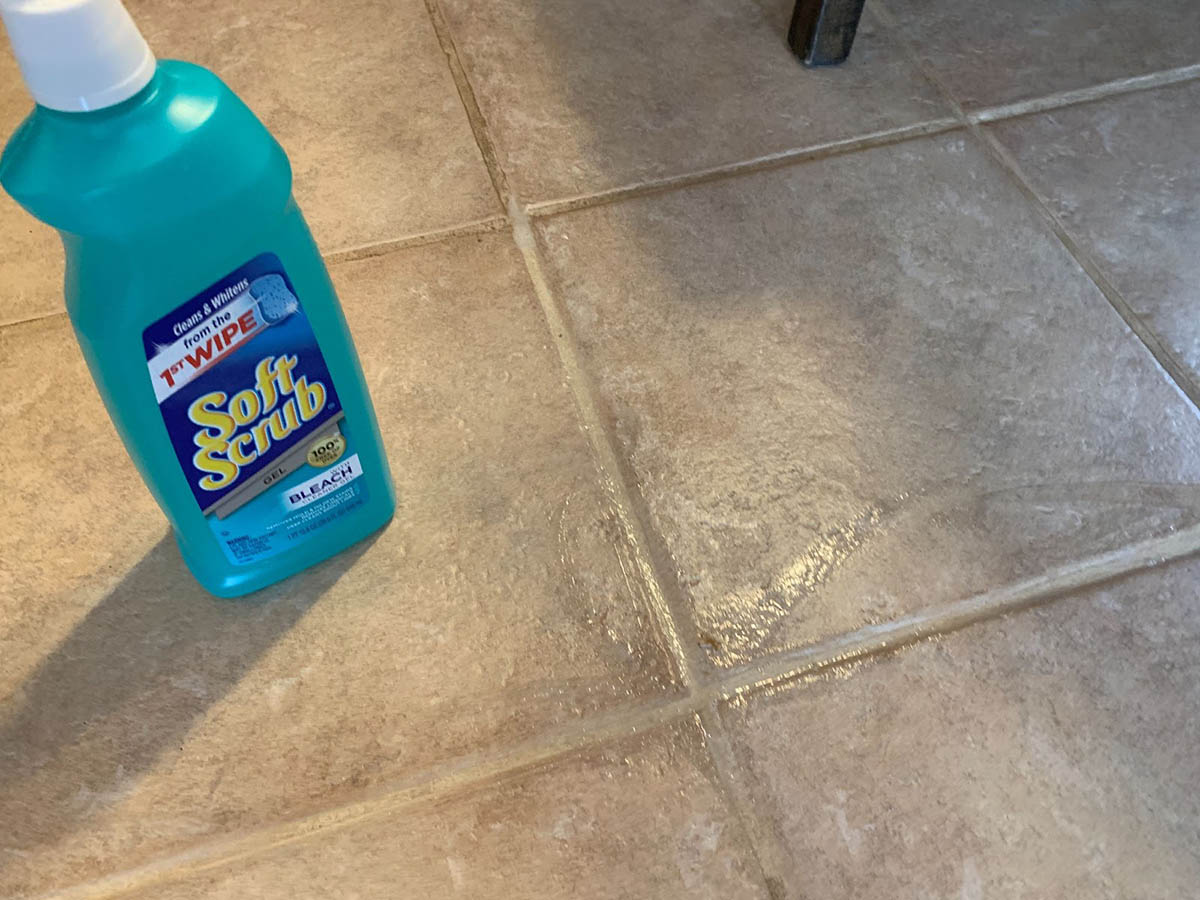
How We Tested the Best Grout Cleaners
We tested the cleaners on the (very filthy) grout in our kitchen and bathroom floors, mudroom, and showers and tubs. We looked at a few primary aspects for testing:
- How easy it was to the apply the cleaner where we wanted it
- The smell
- How long we had to let the cleaner sit in order for it to work
- How much scrubbing was needed to get the area clean
- How effective the cleaner was to whiten and brighten the grout and/or clean the area
- How well it removed any stains
- How much rinsing was needed to remove the product and what kind of residue was left
Our Top Picks
There are many types of grout cleaners designed for specific jobs, from antibacterial cleaning to blasting through dirt and soap scum. We tested a variety of the most popular options to see how they stood up to their claims. Check out how the following cleaners met the requirements of our hands-on testing process.
Best Overall
Soft Scrub with Bleach Cleaner Gel
The Soft Scrub with Bleach Cleaner Gel was our favorite cleaner by far when testing. Not only did it work incredibly quickly and easily on all of the filthy grout surfaces in our house—including a kitchen, bathroom, and mudroom that five children, two adults, and one farm dog use—it also can clean pretty much anything in the house, including countertops, tubs, showers, sinks, stovetops, tiles, and toilets.
It contains bleach, so it will clean everything from mold to mildew to limescale stains to plain old grime. It made our grout whiter and cleaner than any other cleaner, and the difference was drastic. The only warning to be aware of when using Soft Scrub with Bleach is that it will stain dark clothing, so be sure to dress accordingly or wear protective gear when cleaning. Additionally, using bleach frequently on grout can damage it over time, so use this cleaner sparingly, and be sure to follow all recommended instructions, and do not let it sit for longer than the recommended 1 minute of soaking time.
We will admit that it would have been nice to have the convenience of a spray bottle, but the fact that it basically melted off stains and dirt makes it worth using a squeeze bottle. Plus, it’s affordable.
Product Specs
- Application: Squeeze-on gel
- Meant for: Safe for all surfaces, although prolonged contact with metal, old porcelain, or plastic countertops may cause discoloration
- Special features: Dye-free, made in the USA
Pros
- Formula is very effective at whitening
- Gel is very powerful at cleaning; no scrubbing needed
- Leaves behind a pleasant smell instead of a harsh chemical odor
Cons
- Contains bleach; will stain clothing very easily
- May not be safe for all surfaces
Get Soft Scrub bleach cleaner gel at Amazon.
Runner-up
Black Diamond Ultimate Grout Cleaner
The Black Diamond product is an excellent grout cleaner because it hits all of the key grout cleaning boxes: It came as a convenient spray, worked very quickly, required minimal scrubbing, and brightened almost as well as our Best Overall pick but without bleach. With the active ingredients of sodium xylene sulphonate, dodecyldimethylamine oxide, 2-aminoethanol, benzyl alcohol, and 3-butoxypropan-2-ol, it does have a pretty strong smell, so it’s important to ventilate the space when using it.
Additionally, keep in mind that because it’s acid-free, it won’t clean calcium or water spots on showers and tubs. What it is good for, however, is cleaning both white and colored grout lines, along with dirt and soap scum. We also noticed that this cleaner required a good rinsing; even after one rinse, we could still feel a bit of a residue left on the floor.
Product Specs
- Application: High- or low-flow spray
- Meant for: Tile grout only
- Special features: Acid-free
Pros
- Convenient spray bottle is easy to apply
- Works immediately; no need to wait after application
- Cleans and brightens grout effectively
Cons
- Strong smell; may not be to everyone’s taste
- Won’t remove calcium or water spots
- Will leave residue if not rinsed properly
Get Black Diamond grout cleaner at Amazon or The Home Depot.
Best Bang for the Buck
CLR Brilliant Bath Cleaner
If there are stains from hard water or a lot of calcium and lime discolorations, this CLR cleaner is worth trying—just be sure to spray and let it sit for at least 2 minutes before scrubbing. Meant for cleaning hard-water buildup, calcium deposits, lime, and dirt from kitchen and bathroom surfaces, this foaming, fresh-scent spray is a go-to option for targeted jobs instead of general grout cleaning. It’s ideal for showers with hard-to-reach corners, for instance, because the spray can be applied liberally.
It is safe for tile and ceramic as well as glass and stainless steel. We found that it worked almost as well as our Best Overall pick but without the bleach. However, it did require a lot of rinsing to prevent the floor from being slippery.
It’s also hard to find a tough cleaner that doesn’t contain loads of toxins and harsh chemicals. So we’re thrilled to see the EPA’s Safer Choice program label on CLR’s spray bottle. This certifies that CLR contains no ammonia, bleach, or phosphates and contains lactic acid, lauramine oxide, and tripropylene glycol n-butyl ether as its active ingredients.
Product Specs
- Application: On/off spray
- Meant for: White grout, chrome, stainless steel, glass, and granite; not safe for colored grout, marble, and finishes
- Special features: EPA Safer Choice certified and part of the EPA’s Safer Choice program
Pros
- Minimal scrubbing needed; great for cleaning large areas
- Spray bottle makes for easy application
- No harsh smell compared to other grout cleaner products
Cons
- Didn’t whiten as much as some other cleaners
- Required a brush for cleaning
- Must rinse well or will leave floor slippery
Get the CLR Brilliant Bath cleaner at Amazon or The Home Depot.
Best Eco-Friendly
Seventh Generation Professional Tub & Tile Cleaner
As an all-purpose cleaner, this eco-friendly pick can be used to clean both grout and surfaces in the kitchen and bathroom. It may not whiten and brighten as well as more harsh cleaners, but we do like the idea of a more gentle, nontoxic cleaner for the tub that toddlers and children will use for bathing. Just keep in mind it’s not the most effective cleaner for removing tough stains or a lot of mold and mildew, but for everyday cleaning or simple dirt and soap scum, it gets the job done.
This cleaner is a way to both prevent and cure in one concentrated solution. Its eco-friendly liquid is formulated with citric acid, plant-based ingredients, and essential oils—without chlorine bleach, artificial fragrances, dyes, or solvents. Instead, the main ingredients in this cleaner are water, citric acid, caprylyl/myristyl glucoside (a plant-derived cleaning agent), abies balsamea (balsam fir) extract, citrus aurantifolia (lime) oil, and cupressus sempervirens (cypress) oil.
It is safe for use on a range of surfaces, including ceramic tile, shower doors, plastic, chrome, fiberglass, porcelain, stainless steel, and more (it’s not advised for marble or brass, though).
While this tub and tile cleaner doesn’t include fake fragrances, it is scented quite heavily with essential oils, so people with sensitivity to smells should take note. Additionally, it might be helpful to decant into a spray bottle, as the product is sold as a pourable bottle only. A
Product Specs
- Application: Pour-on
- Meant for: Acrylic, ceramic, fiberglass, porcelain, satin, nickel, stainless steel; not for use on marble or glass
- Special features: Septic safe, biodegradable, USDA Certified Biobased Product, nontoxic
Pros
- Nontoxic formula is less harsh than other cleaners
- Pleasant smell that’s not too overpowering
- Biodegradable formula; great for eco-conscious users
Cons
- Very large refill bottle; heavy and difficult to use without decanting into another bottle
- Won’t whiten grout or remove mold or mildew
Get the Seventh Generation professional tub and tile cleaner at Amazon.
Best Heavy-Duty
Grout-Eez Super Heavy Duty Tile & Grout Cleaner
As much as we love a good earth-friendly cleaner, we know that some tough jobs require specialized formulas. For moldy, stained grout that won’t respond to everyday cleaners, Grout-Eez performs well. This “super heavy-duty” solution is designed for maximum cleaning power, especially on floors and large surfaces.
With a squeeze-top, targeted nozzle, and large brush that can attach to any standard broom pole, Grout-Eez does attempt to make grout cleaning easy without bending or scrubbing required. Plus, the brush can also be used without attaching it to anything, which is how we tested it—it still works. We found we liked a more targeted brush to scrub grout lines, but a floor brush could have many useful applications for those with mobility challenges.
Grout-Eez promises to suck up dirt, grease, and stains in about 5 minutes. Upon testing, we found that it only required about 3 minutes of soaking before it was ready to clean and only needed minimal scrubbing. It did clean and whiten our tile grout, but it didn’t get it as white as the Best Overall pick.
Safe for most tiled surfaces (but not natural stone), the active ingredients include urea monohydrochloride (a strong acid) and nonylphenol ethoxylates (a chemical detergent). Due to these chemicals, Grout-Eez does create fumes, so always wear protective gear (goggles, mask, and gloves). The cleaner has a very harsh smell, so it may be best used for heavy-duty jobs in well-ventilated areas and not for everyday cleaning.
Product Specs
- Application: Targeted nozzle
- Meant for: Most tiled surfaces; not for use on natural stone or metal
- Special features: Includes brush
Pros
- Includes brush with the cleaner; great all-in-one product
- Targeted nozzle great for getting into grout lines
- Strong active ingredients means minimal scrubbing needed
Cons
- Brush not as effective as others
- Very harsh smell
- Not as effective as other cleaners on kitchen tile grout
Get the Grout-Eez tile and grout cleaner at Amazon.
Best for Large Areas
Zep Grout Cleaner and Brightener
If the goal is to do a whole floor or area or clean large surfaces, the Zep Grout Cleaner and Brightener is a product to try. This cleaner doesn’t come with a spray nozzle or a targeted spout, so it’s best for using over large areas that necessitate a pour-out. With the strong active ingredients of urea hydrochloride and hydrochloric acid, ZEP is designed for commercial as well as residential use.
One convenient feature is that it can be used on both colored and white-only grout lines. However, keep in mind that it’s only to be used on grout lines—it can’t be used on marble, terrazzo, travertine, natural stone, chrome, stainless steel, brass, or Corian surfaces. It also won’t remove mold, mildew, calcium or limescale, and rust, so again, just keep it for grimy grout.
Product Specs
- Application: Pour-on spout
- Meant for: Only safe for tile grout; can’t use it on marble, terrazzo, travertine, natural stone, chrome, stainless steel, brass, or Corian surfaces
- Special features: Commercial grade
Pros
- Minimal scrubbing required; helps minimize user fatigue
- Good for larger areas and surfaces
- Very strong cleaner suitable for a wide range of surfaces
Cons
- Pours out from top, no nozzle or targeted application
- Doesn’t remove mold, mildew, calcium or limescale, and rust
- Doesn’t whiten as effectively as some other cleaners
Get the ZEP grout cleaner at Amazon or The Home Depot
Best Grout Cleaning Tool
Oxo Deep Clean Brush Set
For small, hard-to-reach areas and grout lines to clean, like around faucets, behind sinks, or in tiny niches in the shower, this grout cleaning tool from Oxo is a great helper. It’s not ideal for scrubbing floors or areas that need a lot of elbow grease, but it helps with detailed work that needs to be done. Either of these angled brushes will help with the job. Plus, the brushes are small enough that they won’t damage grout.
Product Specs
- Application: 2 brushes
- Meant for: All tile grout lines
- Special features: Angled brush
Pros
- 2 brush sizes can help with a variety of cleaning tasks
- Affordable set of brushes offering great versatility
- Angled brush heads make it easier to scrub with
Cons
- Smaller brush not ideal for major scrubbing
- May be uncomfortable for extended periods of time
- Can be too “bendy” for difficult spots
Get the Oxo brush set at Amazon or Target.
ALSO TESTED
Microban 24 Hour Bathroom Cleaner
We also tested this bathroom cleaner, which, while not specifically a grout cleaner, is a great option for antibacterial cleaning or high-traffic areas. It cleans, sanitizes, disinfects, and removes soap scum, mold, and mildew. While this is not a cleaner for getting off tough stains, it is a cleaner that’s good for sanitizing areas like showers and tubs. Plus, it can inhibit mold and mildew growth for up to a week after cleaning. It can keep hard, nonporous surfaces sanitized for 24 hours. However, it’s not recommended for use on unfinished, oiled, or waxed wood surfaces.
We tested this cleaner on some tough stains on an apartment tub (so it’s seen some stains), and while it removed some of the stains, it definitely did not work as well as other cleaners. We’d recommend a different cleaner for removing tough stains and using this as sanitization and prevention.
Bar Keepers Friend Soft Cleanser Liquid
We did not find any tough stain that this product could remove. For instance, we tested on both stainless steel cookware and a teapot, which, according to the product description, the product is specifically designed for. Unfortunately, it did not do anything to remove any of the stains from the stainless steel pans or teapot. Additionally, it’s not a grout cleaner.
Jump to Our Top Picks
What to Consider When Choosing a Grout Cleaner
Grout cleaner should be gentle enough to polish tile without scratching it but strong enough to eliminate grout discoloration due to mold, mildew, and dirt. Whether cleaning a floor, kitchen backsplash, or shower stall, the best results can depend on the following factors:
Active Ingredients
To be effective, grout cleaners lift dirt, erase mold, clean soap scum, and brighten tile with ease. Choose a product based on the desired result.
Mold and Mildew Removal
Depending on the severity of the mold situation, a grout cleaner with one of the following ingredients may be desired: an acid, hydrogen peroxide, oxygen bleach, or chlorine bleach.
- A mild acid-based cleaner (containing citric or oxalic acid, for example) is the least harsh of these formulas and typically won’t damage chrome, stainless steel, or tile.
- An oxygen bleach (containing hydrogen peroxide) is moderately strong, while chlorine bleach is the strongest and most caustic.
- Chlorine bleach formulas should only be used when the goal is to whiten, as they can also lift color from dyed grout.
All of these ingredients will also kill germs and bacteria, which, when applied in low doses, can be helpful, especially in bathroom and kitchen areas.
Whitening and Brightening
While chlorine bleach is often a go-to ingredient in whitening products, it is not necessarily the best or only option. Bleach is associated with health concerns (respiratory damage, for example), and it can also release harmful airborne particles when mixed with other cleaning substances. That said, it can have a place in a cleaning regimen if used in small doses.
Beyond bleach, citric and oxalic acid can also lift soap scum and surface staining. The right abrasive product can really get the dirt out, restoring grout and tile to an almost-new appearance. Look for products containing feldspar. This naturally occurring mineral is crushed into a fine powder, which works wonders on hard surfaces, including grout and tile.
Grout Color
It’s important to make sure a grout cleaner is appropriate for the grout color. Not all grout cleaners are intended to clean colored grout. Some, like those that contain bleach, are designed to only whiten and brighten white grout lines.
While bleach and other harsh cleaners can be effective for cleaning white grout lines, they can also break down the grout over time and eventually cause damage that will allow mold to grow. Additionally, breaking down the grout can lead to even more discoloration. If there are colored grout lines, be sure the grout cleaner is safe for colored grout.
Grout is porous, so it will absorb any cleaner used on it, and using the wrong cleaner could damage the grout lines.
Tile Material
Not all grout cleaners can be used on all types of tile material. The more porous the tile material, the more likely it is that the wrong grout cleaner could damage the tile or cause discoloration. Some materials are more porous than others. For instance, sandstone is very porous, while granite is not very porous.
One of the common warnings regarding grout cleaners are for natural stone surfaces, which are susceptible to discoloration. Check the label for a list of what type of materials the grout cleaner can and cannot be used on.
If unsure about the tile material, test the tile by putting a drop of water on it. If the water absorbs and leaves a “wet” mark, it’s likely very porous. If the water sits on the tile and doesn’t absorb, it is nonporous. Use additional caution when working with porous tile.
Cleaning Time
Most grout cleaners will need to be applied and allowed to sit for several minutes before scrubbing in order to be the most effective. And some strong cleaners come with a clear warning to not let the cleaner sit more than the allotted time. In fact, letting the cleaner sit longer than the recommended time could actually damage the grout and/or the tile. For instance, abrasive cleaners that contain bleach or other acid-based cleaners can cause damage to the grout over time.
Additionally, using harsh scrubbing action with abrasive cleaners can cause holes and break down the grout, which can lead to discoloration. If there are any holes and breakdowns, the grout will need to be repaired.
Application Method
There are two ways to apply grout cleaner: (1) spray and wipe, or (2) scour with a brush. Spray-on products claim to work without scrubbing, which can save time and energy. On the downside, these cleaners may contain harsher acids, solvents, or chlorine bleach. Therefore, it’s important to weigh the benefits of elbow grease saved with the toxins released into the home environment.
Scouring with a brush and cleaner does require a little work, but this method can be especially effective on floors and heavily soiled grout. For tools, a toothbrush can be used on small grout lines. A brush or scrub pad is best for floors and backsplashes. Some brands provide both the liquid cleaner and a scrubbing tool or broom head. To prevent scratching the surrounding tile, use gentle pressure and avoid overly vigorous scrubbing.
Health and Surface Safety
A variety of harsh chemicals can be found in some commercial grout cleaners, with bleach and ammonia often playing a key role. These active ingredients can be efficient at scouring away surface stains, soap scum, and mold, but they can also affect the user’s health adversely as well as harm the environment.
- Chlorine bleach and ammonia can be caustic and poisonous if improperly used. Both chemicals can cause skin and eye irritation as well as respiratory damage. At the same time, their whitening powers are almost unbeatable, especially where tough grout stains, mold, and mildew are concerned.
- High levels of phosphates have been linked to irritation in humans, as well as having an impact on water systems and aquatic life. However, they are also useful in softening water, cutting through soap scum, and improving cleaning products’ efficiency. Since the 1960s, the U.S. has been increasing regulation on phosphates, which has removed this additive from many cleaning products and detergents, though not all. This is why “phosphate-free” still appears on the label of some grout cleaners.
Before ramping up product strength and turning to bleach or man-made chemicals, consider trying a healthier, plant-based option first. They are still effective in most situations. Look for products with the Environmental Protection Agency (EPA)’s Safer Choice seal as well as a list of active ingredients. If the brand does not disclose all its ingredients on the label, search the Environmental Working Group’s Guide to Healthy Cleaning. This database provides independent research on product toxicity and safety.
For our recommendations, we’ve prioritized the safest options on the market today. The two exceptions are bleach and industrial-strength grout cleaner, which are still useful in certain circumstances. Any formulas labeled heavy-duty or containing these chemicals require careful handling and protective gear: rubber gloves, face mask, goggles, and good ventilation.
Most grout cleaners will also coat surrounding surfaces, so make sure the product is formulated for safe contact with those materials. Always double-check the label, as most grout cleaners list the surfaces they are designed for. In the case of granite, marble, and unsealed natural stone, look for cleaners designated safe for these materials.
Before spreading grout cleaner over an entire backsplash or tiled surface, spot-test it on a small, unnoticeable area. This is especially important for industrial-strength cleaners.
How to Protect Tile Grout
One consideration when cleaning tile grout is that, depending on the type of grout cleaner used and how long it’s left to sit (for instance, going over the recommended amount of time), it could effectively damage the grout. To help protect grout and prevent future stains, buildup, and mold and mildew growth, consider sealing grout after cleaning. A good goal is to seal grout at least once a year and more frequently if it’s a high-traffic area or if you’re cleaning the grout often.
FAQs
Grout cleaner may not be a cleaning product you use often, so you may have some questions about how to best use grout cleaner. Below are answers to some popular questions about grout cleaners.
Q. Is bleach bad for grout?
Using bleach frequently to clean grout can eventually damage the grout’s structure, so use it sparingly. Additionally, there is a risk of damaging or discoloring nearby surfaces, so bleach-based cleaners should be used carefully.
Q. How do you clean really dirty grout?
Choose a cleaner tailored to the type of debris that is being removed. Mold and mildew, for instance, may require a different cleaning agent than simple dirt does.
Q. Is it important to seal grout lines?
It can be helpful to seal grout lines at least once a year to help protect them and prevent staining.
Q. How often should tile and grout be cleaned?
At the least, it’s recommended that grout and tile are cleaned every 6 months, but some tile and grout may need cleaning more frequently in high-traffic areas or areas prone to mold and mildew growth, like showers.

